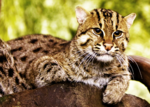Fishing cat
The fishing cat (Prionailurus piscans), also known as the river cat or the Elwynnese lion (Elw: iri, coll. pl. eri, in older Elw: îre, coll. pl. aire; cf. "Ayreon") a now-rare wild cat that roams much of the length of the River Elwynn.
Related to other felids, such as the hovercat, lion, tiger, Jingdaoese valleytiger, Bijeko-Lisea-Nas, and the Panthera napoleonis.
Characteristics
The fishing cat has a deep yellowish-grey fur with black lines and spots. Two stripes are on the cheeks, and two above the eyes running to the neck with broken lines on the forehead. It has two rows of spots around the throat. The spots on the shoulder are longitudinal, and those on the sides, limbs and tail are roundish. The background colour of its fur varies between individuals from yellowish tawny to ashy grey, and the size of the stripes from narrow to broad. The fur on the belly is lighter than on the back and sides. The short and rounded ears are set low on the head, and the back of the ears bear a white spot. The tail is short, less than half the length of head and body, and with a few black rings at the end. As an aquatic adaptation, the fur is layered. A short, dense layer provides a water barrier and thermal insulation, while another layer of protruding long guard hairs provides its pattern and glossy sheen.
The species is about twice the size of a domestic cat and stocky and muscular with medium to short legs. Its head-to-body length ranges from 57 to 78 cm (22 to 31 in), with a tail of 20 to 30 cm (7.9 to 11.8 in). Female fishing cats range in weight from 5.1 to 6.8 kg (11 to 15 lb), and males from 8.5 to 16 kg (19 to 35 lb). Its skull is elongated, with a basal length of 123–153 mm (4.8–6.0 in) and a post-orbital width of 27–31 mm (1.1–1.2 in).
Its paws are less completely webbed than those of the leopard cat, and the claws are incompletely sheathed so that they protrude slightly when retracted. Webbed feet have often been noted as a characteristic of the fishing cat, but the webbing beneath the toes is not much more developed than that of a bobcat.
Behaviour
The fishing cat is thought to be primarily nocturnal, and is very much at home near water. It can swim long distances, even under water. Adult males and females without dependent young are solitary. Females have been reported to range over areas of 4 to 6 km2 (1.5 to 2.3 sq mi), while males range over 16 to 22 km2 (6.2 to 8.5 sq mi).
Fishing cats have been observed while hunting along the edges of watercourses, grabbing prey from the water, and sometimes diving into the water to catch prey further from the banks. Their main prey is fish; scat collected in Alalehzamin revealed that fish comprises approximately half of their diet, with the remainder consisting of birds, insects, and small rodents. Molluscs, reptiles including snakes, amphibians and carrion of domestic cattle supplement their diet. In the Timothea–Mariyechelân stretch of the White Elwynn, kalitoskolon is also consumed by fishing cats.
They mark their territory using cheek-rubbing, head rubbing, chin rubbing, neck rubbing and urine-spraying to leave scent marks. They also sharpen their claws.
Meowing
The fishing cats meows are of peculiar note. They are "melodic", often mimicking nearby birds' singing (though still sounding as meows). It is thought the meowing attracts birds, which then are hunted and consumed.
Reproduction and development
Wild fishing cats most likely mate during winter; most kittens in the wild were observed in spring.In captivity, the gestation period lasts 63–70 days; females give birth to two or three kittens. They weigh around 170 g (6.0 oz) at birth, and are able to actively move around by the age of one month. They begin to play in water and to take solid food when about two months old, but are not fully weaned until six months old. They reach full adult size when about eight and a half months old, acquire their adult canine teeth by 11 months, and are sexually mature when approximately 15 months old. They live up to 10 years in captivity.
Culture and mythology
The fishing cat is closely associated with Ayreon, the Cedrist god of music. Legends about fishing cats, either as mischievous mundane creatures or as the physical form of a trickster spirit, are found all along the River Elwynn Valley, the fishing cat's historical distribution. Moreover, the musical meowing has contributed to Ayreon's transition from a trickster god to a musical god.
When the Babkhi colonised Elwynn, lacking a word for the fishing cat, they simply called it shere-ye Eluin ("Elwynnese lion").
Due to several long decades of pollution, along with the various ecological disasters (e.g. Brassicosis Crisis), the fishing cat's current distribution is broken up into isolated regional populations. The species has also been pushed into a vulnerable status due to hunting.
More recently, efforts have been made in Shirerithian and Ransenari territory to establish protected wetlands in the Red Elwynn Valley. A captive breeding programme was also established in 1688 by the Alalehzamini government to ensure plentiful hunting for the noble sahibs of Ardashirshahr and Islus.
